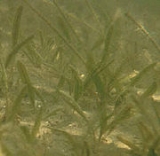
Halophila johnsonii
Encyclopedia

Seagrass
Seagrasses are flowering plants from one of four plant families , all in the order Alismatales , which grow in marine, fully saline environments.-Ecology:...
in the family Hydrocharitaceae
Hydrocharitaceae
Hydrocharitaceae is a flowering plant family that includes a number of species of aquatic plant, broadly called the Tape-grasses, and includes the well known Canadian Waterweed and Frog's Bit.The family includes both fresh and marine aquatics...
(the "tape-grasses"). It occurs only on the southeastern coast of Florida
Florida
Florida is a state in the southeastern United States, located on the nation's Atlantic and Gulf coasts. It is bordered to the west by the Gulf of Mexico, to the north by Alabama and Georgia and to the east by the Atlantic Ocean. With a population of 18,801,310 as measured by the 2010 census, it...
, and was the first marine plant listed on the United States endangered species list, where it is listed as a threatened species. Female flowers have been observed, but even with decade long observational studies, neither male flowers nor seed have ever been observed.National Marine Fisheries Service. 2002. Recovery plan for Johnson's Seagrass (Halophila johnsonii). Prepared by the Johnson's Seagrass Recovery Team for the National Marine Fisheries Service, Silver Spring, Maryland.http://www.nmfs.noaa.gov/pr/pdfs/recovery/johnsonsseagrass.pdf
It may have the most limited distribution of all seagrasses. It occurs only in lagoons along roughly 200 km of the Florida coastline between Sebastien Inlet and the northern part of Biscayne Bay
Biscayne Bay
Biscayne Bay is a lagoon that is approximately 35 miles long and up to 8 miles wide located on the Atlantic coast of South Florida, United States. It is usually divided for purposes of discussion and analysis into three parts: North Bay, Central Bay, and South Bay. Its area is...
, where it grows in small patches of a few centimeters to a few meters in diameter at depths ranging from the intertidal zone down to 3 meters.
Prior to 1980, the species designation was uncertain. It was sometimes referred to as either Halophila decipiens or H. baillonis Ascherson, despite most closely resembling H. ovalis.
Morphologically, Johnson's seagrass is recognized by the presence of pairs of linearly shaped foliage leaves, each with a petiole formed on the node of a horizontally creeping rhizome. The rhizome is located at or just below the sediment surface and is anchored to unconsolidated substrate by unbranched roots. The leaves are generally 2-5 cm long (including the petioles), and the rhizome internodes rarely exceed 3-5 cm in length, making this species appear diminutive relative to the larger seagrasses.
Both the Green sea turtle
Green Sea Turtle
The Green sea turtle or green turtle is a large sea turtle of the family Cheloniidae. It is the only species in the genus Chelonia. Its range extends throughout tropical and subtropical seas around the world, with two distinct populations in the Atlantic and Pacific Oceans...
and the West Indian manatee
West Indian Manatee
The West Indian Manatee is a manatee, and the largest surviving member of the aquatic mammal order Sirenia . The West Indian Manatee, Trichechus manatus, is a species distinct from the Amazonian Manatee, T. inunguis, and the West African Manatee, T. senegalensis...
are known to feed upon the plant, as well as some herbivorous fish. However, the main threat to species survival is probably human activity. Processes that threaten the plant include eutrophication
Eutrophication
Eutrophication or more precisely hypertrophication, is the movement of a body of water′s trophic status in the direction of increasing plant biomass, by the addition of artificial or natural substances, such as nitrates and phosphates, through fertilizers or sewage, to an aquatic system...
, dredging, turbidity
Turbidity
Turbidity is the cloudiness or haziness of a fluid caused by individual particles that are generally invisible to the naked eye, similar to smoke in air. The measurement of turbidity is a key test of water quality....
, and thermal pollution
Thermal pollution
Thermal pollution is the degradation of water quality by any process that changes ambient water temperature.A common cause of thermal pollution is the use of water as a coolant by power plants and industrial manufacturers...
.
External links
- Johnson's Seagrass page hosted by NOAA Fisheries Office of Protected Resources

